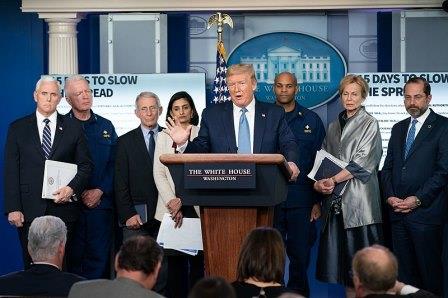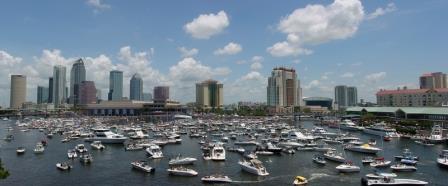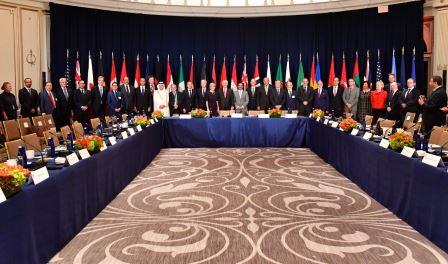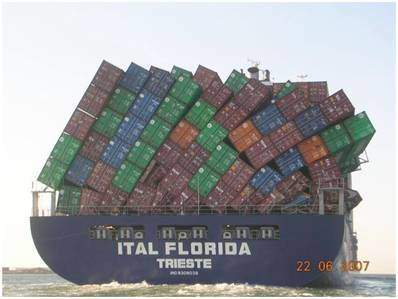A Post-COVID Vision: The Full and Sustainable Employment Act
by Brian Czech
If COVID-19 has taught us anything, it is that the Great God of GDP is a false god after all, impotent as Baal. The mighty American economy, with unprecedented GDP, has been knocked to its knees by one of the lowest conceivable life forms, a mere virus possessing not a single strand of DNA. Politicians who thought their legacies would be associated with “the greatest economy ever” now look like ridiculous priests of a sham religion.
GDP exceeding $21 trillion in 2019 ($87 trillion globally) has been powerless to cure the sickness, financial trauma, and fear experienced by millions of Americans and billions of souls worldwide. Adapting to the new reality of a COVID-infected world and the uncertain hope for a vaccine is depressing in the best of scenarios and devastating in the worst. Yet adapt we must, and that includes public policy as much as individual behavior.

Pushing for growth vs. protecting the public: COVID-19 as the latest episode. (CC0, The White House)
The CDC, NIH, and WHO have provided recommendations for lowering the spread of the virus and helping infected patients survive. Politicians are attempting to balance such recommendations with the concern for a healthy economy. The problem is that virtually every major politician in the USA, as well as a majority of politicians in the world, think of economic health in terms of GDP growth. For that matter, so do the economists advising these politicians and appearing on mainstream media. Their “adaptation” to the COVID-caused recession is nothing more than a hapless attempt to get back to business as usual; that is, growing the GDP through fiscal and monetary “stimulus.” In other words, it’s no adaptation at all!
Common sense and a pair of eyes is enough to recognize that the need for social distancing—effective adaptation to COVID-19 at the individual level—translates into lower levels of economic activity and a lower velocity of money. Unfortunately, politicians are now handling public health as they handled environmental protection for decades, acting as if we can have our cake and eat it too. They seem to think that, with enough Plexiglas panels on factory floors and retail counters, we can stimulate the economy back into $21-trillion territory without suffering a pandemic death toll. We can expect claims of “there is no conflict between growing the economy and protecting public health,” echoing the decades-old mantra that “there is no conflict between growing the economy and protecting the environment.”
Will we be fooled again by the win-win rhetoric? I don’t think so—at least not nearly so many of us—because this time the threat of the growth obsession is a direct, imminent matter of life or death. As employees are prematurely pressured to return to work “for the economy,” knowing fully well that doing so increases their odds of contracting the deadly virus, surely they will rethink what “the economy” is really for and who is behind the push to “stimulate” it.
There will be a significant percentage of individuals who decide more or less happily never to return to the jobs that dominated their life pre-COVID. Many will wrestle with trade-offs, such as extra gardening and more childcare, and certainly less luxury goods and entertainment. Some will have saved enough—and were cautious enough to avoid debt traps—such that they may find the new lifestyle to be empowering and even more joyful than the old 9-to-5 grind. They won’t be contributing much to GDP, but they’ll be healthier and happier, and will hardly be a burden on the nation’s infrastructure and budget.
Unfortunately, many others will be desperate to return to work or find a new job. They may have little means of subsistence—no lawn for a victory garden—and some will be threatened with homelessness when they can’t pay the rent. Even they, however, will see through the lie that “there is no conflict between growing the economy and protecting the public from COVID-19.” They are victims of an unfair capitalist system who must go to work “for the economy” and risk their health in the process.
The experience of individuals far and wide, then, will be conducive to a sea-change in attitudes toward the economy, GDP growth, and the government’s role in defending its own taxpaying citizens.
A New Economic Policy for 21st Century America
A new policy vision for the post-COVID economy entails replacing the current policy. So, what exactly is the current policy? What is it that steers us constantly, relentlessly back onto the GDP growth path? Let’s take a short trip down institutional memory lane…

President Harry Truman signed the Employment Act in 1946; a first step in the formal pursuit of GDP growth. (CC0, Abbie Rowe)
As a response to the Great Depression, Franklin Delano Roosevelt gave Americans the New Deal. Most of the work programs were cultural successes and employed significant numbers of young men. Yet the Depression wasn’t “solved” until World War II, with the mobilization of the civilian labor force and technological progress spinning out of war-time laboratories. Most Americans know this basic story of the Great Depression, New Deal, and World War II, but few seem aware of the Employment Act of 1946. We must be fully aware of it to move toward a new economic policy for the 21st century.
The Employment Act was a Keynesian adaptation to the experience of the Great Depression; that is, it was largely a result of John Maynard Keynes’ General Theory of Employment, Interest, and Money. Prior to Keynes, economists clung stubbornly to their ideal of laissez faire (let do; non-interference) as the proper governmental approach to economic affairs. General Theory was the paradigm-shifting book that persuaded Western governments to take active fiscal and monetary measures for ensuring adequate demand for goods and full employment of the labor force.
In crafting the Employment Act, the 78th Congress was especially concerned about the social and cultural ravages of unemployment. It was less concerned with any explicit notion of economic growth. For one thing, national income accounting was in its infancy. Also, Congress was still reluctant to get the federal government very involved in economic affairs, especially with heightened concerns over the sway of communist ideology. That said, the Employment Act did establish the Council of Economic Advisors, which turned out to be a highly influential pro-growth institution for decades to come.
The American economy ran fairly smoothly and grew very rapidly for the next couple of decades, but by the 1970s, American political leadership was beside itself with the problem of stagflation, that is, recession (“stagnation”) concurrent with inflation. Economists thought you could have only one or the other for any significant period of time and that they were, in fact, countervailing forces. Unlike World War II, though, the Vietnam War wasn’t sufficient to kick the real economy into high gear. Efforts to stimulate investment and consumer spending by loosening the money supply only led to inflation. Thus, stagflation.
The bedeviling bouts of stagflation finally led Richard M. Nixon to announce, “We are all Keynesians now,” recognizing that conservative diehards were some of the last to accept any government involvement in macroeconomic policy. Nixon had established the Bureau of Economic Analysis in 1972 for state-of-the-art accounting and GDP calculation. The 95th Congress, led by Hubert Humphrey and Augustus Hawkins, worked to update the Employment Act, which was finally amended as the Full Employment and Balanced Growth Act (FEBGA) and signed by President Carter in 1978. As of then, the US government was fully and formally committed to GDP growth as central economic policy.
It was easy for supporters of FEBGA to argue mathematically that, all else equal, more jobs could be had with greater GDP. It was also easy for Big Money to hide behind pro-growth policy for purposes of accumulating more capital and increasing CEO salaries, without any concern for creating more jobs. Not surprisingly, FEBGA ended up a thick mix of fiscal and monetary policy that serves the capitalist as well as the labor force.
FEBGA is often referred to with the shorthand “Employment Act,” saving a number of syllables and reminding us of its original (1946) focus. I favor the full 1978 title, even if only via acronym, as a reminder that GDP growth is not just some wistful political notion or rhetorical tool but rather a formal, central policy of the USA pursued with fiscal, monetary, and deregulatory means, as well as diplomacy and terms of trade in international affairs.
Now, more than a half century later and in the midst of an economy-crushing pandemic, it’s time to rewrite FEBGA. We need a Full and Sustainable Employment Act, with the very name change communicating that growth is no longer sustainable.[1] The Full and Sustainable Employment Act will mark the transition from economic growth to a steady state economy, politically and every bit as formally as FEGBA called for growth.
Pro-growth politicians (or perhaps Big Money) came up with the brilliant metaphor, “A rising tide lifts all boats.” While at least one source attributes the phrase to President John F. Kennedy, it seems like the stuff of Madison Avenue. And, when limits to growth aren’t acknowledged, the logic illustrated by the metaphor is unassailable. All else equal (“ceteris paribus” in econ-speak), a growing GDP means more jobs. Of course the devil is in the phrase “all else equal,” because little is equal on the tilted chess board of a capitalist economy. Instead of more jobs, a growing GDP too often means more expensive technology and billionaire CEOs, who are just as effective at blasting ships out of the water as making way for more boats.
Either way, the metaphor of the rising tide sinks like a presidential approval rating when limits to growth are recognized, as they increasingly are and should especially be in the context of COVID-19. There is only so much water; the tide can’t rise forever. There is a limit to the number of boats at sea, too, and even a limit to boat-building material on shore. It’s high time for the “rising tide” metaphor to ebb all the way back into the rustic recesses of faded political minds.
It so happens that the acronym of Full and Sustainable Employment Act—FSEA—is useful for nailing the coffin shut on the “rising tide” metaphor. Combining “F” (for Full) and “SEA” invokes the image of a full sea. Why not take advantage of such a linguistic coincidence and make the message a little clearer yet? It is not unprecedented for Congress to wax metaphorical with the short title of a paradigm-shifting statute; they might as well call this one the “Full Seas Act.”

“A rising tide lifts all boats” was a fine metaphor for the 20th century, but in the 21st century the seas are full. (CC0, Good Free Photos)
What might the Full Seas Act actually look like? How will it conduce a steady state economy? What happens to the pro-growth arrangements established by FEBGA? The best way to envision these developments is to consider a proposed Section 2.[2]
Full Seas Act—Findings and Declaration
In a typical act of Congress, Section 1 provides a short title (“Full Seas Act” in this case). Section 2 is in many ways the most important section of a path-breaking statute because it establishes the key findings and declarations of Congress. It comprises a sort of preamble and emanates the spirit of the law. It justifies the details laid out in subsequent sections, and future policy development at the agency level will be informed by its content as well.
On the other hand, readers should keep in mind that Section 2 is never designed to address all the details of the challenge at hand, much less all the problems of the world. The crux of the Full Seas Act is a formal transition from economic growth to the steady state economy (most likely via degrowth). Therefore, Section 2 will not include references to specific policy tools such as minimum wages, energy caps, banking reforms, etc. Sections 3 and beyond just as surely will, however.
Without further ado, then, the initial public offering of the Full Seas Act, Section 2, more or less consistent with the canons of statutory construction:
SEC. 2.
(a) FINDINGS. The Congress finds that—
(1) Economic growth, as measured with gross domestic product (GDP), requires a growing human population, increasing per capita consumption, or both.
(2) Consistent with the natural sciences, including basic principles of physics and biology, there are limits to economic growth within and among nations.
(3) There is a fundamental conflict between economic growth and environmental protection, including the maintenance of: clean air and water; productive soils; biological diversity; stocks of natural resources including water, timber, fisheries, minerals, and fossil fuels, and; funds of ecosystem services including nutrient cycling, pollination, waste absorption, and carbon sequestration.
(4) A well-maintained, non-degraded environment is the foundation of a productive economy. Therefore, and because of the fundamental conflict between economic growth and environmental protection, there is also a fundamental conflict between economic growth and the long-term maintenance of the economy including jobs, income, and wellbeing.
(5) A well-maintained economy is vital to national defense. Therefore, and because of the fundamental conflict between economic growth and the long-term maintenance of the economy, there is a fundamental conflict between economic growth and national security.
(6) There is abundant environmental and economic evidence that long-term limits to growth have been and are being reached and exceeded in the Nation, other nations, and globally.
(7) There is abundant evidence that perennial fiscal and monetary efforts to stimulate GDP growth are increasingly causing environmental, economic, and social harm while resulting in fewer benefits, with the harm gradually exceeding the benefits.
(b) DECLARATION. The Congress declares that—
(1) It is heretofore the policy of the Nation to undertake a gradual but certain transition from the goal and pursuit of economic growth to the goal and pursuit of a sustainable steady state economy, with stabilized or mildly fluctuating population and per capita consumption as generally indicated, all else being equal, by a mildly fluctuating GDP.
(2) The transition to a steady state economy must be undertaken with every intent and effort to achieve and maintain the full employment of the labor force consistent with environmental protection and other aspects of economic sustainability including a balanced federal budget and the effective control of inflation.
(3) The President, President’s Cabinet, Council of Economic Advisors, Federal Reserve, and federal agency directors will immediately cease and desist from developing strategies and initiatives to grow or stimulate the economy. Existing policies, programs, and projects designed explicitly to grow or stimulate the economy shall not be extended beyond fiscal year 2021 or beyond the designated sunset date, whichever comes later.
(4) The Congressional Research Service, collaborating with the Office of Management and Budget and Council of Economic Advisers, will review and summarize the federal agency mission statements, goals, objectives, policies, programs, and practices designed for GDP growth, producing a Report on Federal Growth Incentives no later than 30 April 2022.
(5) A Commission on Economic Sustainability (“the Commission”) is hereby established to include the Administrator of the Environmental Protection Agency and the Secretaries of Agriculture, Energy, and Commerce, chaired by the Secretary of the Interior, to estimate and monitor environmentally sustainable levels of population and socially optimal levels of GDP. The Commission will produce a Report on Sustainable Population and Optimal GDP no later than 31 August 2022.
(6) The Commission Chair, with counsel of the Chairman of the Council of Economic Advisors, Secretary of Commerce, Federal Reserve Chair, and Secretary of the Treasury, drawing on the Report on Federal Growth Incentives and the Report on Sustainable Population and Optimal GDP, and pursuant to the framework provided in subsequent sections herein, will develop and deliver to the President, no later than 31 August 2023, a 25-year Steady-State Transition Plan detailing and scheduling the adjustments, modifications, additions, and deletions necessary to establish a system of government operations most conducive to a steady state economy at an estimated optimal level of GDP.
(7) The President, Cabinet secretaries, and federal agency directors shall not overlook the existence, neglect the enforcement, or underfund the performance of the Clean Air Act, Clean Water Act, Endangered Species Act, National Environmental Policy Act, or any other of the Nation’s environmental laws or regulations on grounds that said laws or regulations may interfere with the workings of the economy or slow the rate of GDP growth.
Stay Tuned for the Rest of the Full Seas Act
For policy wonks and steady-state advocates, exciting times lie ahead as Sections 3 and beyond of the Full Seas Act will feature long-awaited steady-state policy instruments. The starting point should be the top ten policies favored by Herman Daly. Chapter 11 of Supply Shock is largely for purposes of informing the Full Seas Act. And, at the risk of unintentionally omitting dozens of helpful individuals, now is the time to revisit specific proposals of scholars such as Peter Victor, Tim Jackson, Dan O’Neill, and Phil Lawn as well as the rich mix of overlapping ideas emanating from the European degrowth movement.

“Steady statesmanship” an essential aspect of the Full Seas Act. (CC0, U.S. Department of State)
Speaking of the latter, the Full Seas Act could hardly be effective in a world pursuing GDP growth with only rare exceptions such as Bhutan and New Zealand. Ramped up levels of international trade will be difficult to reconcile with the steady state economy of a huge nation-state. Therefore, the Full Seas Act must address the need for steady statesmanship in international diplomacy.
We should take a page from the playbook of the 93rd Congress, which passed the Endangered Species Act of 1973. Congress used Section 8 largely to implement American obligations pursuant to the Convention on International Trade in Endangered Species of Wild Fauna and Flora, or “CITES,” one of the most sweeping international conservation agreements to date.
Our approach in the Full Seas Act needs to be more proactive, because in this case there is no convention ready and waiting to be implemented. We should devote one section, then, to fleshing out and pursuing the development of a Convention on Economic Sustainability, most likely with a United Nations secretariat. This convention will be assembled for purposes of addressing global limits to growth and the need for “contraction and convergence,” or the acceptance of degrowth in wealthy countries while nations with ubiquitous poverty are assisted to the extent that they have diplomatically established their own sustainable steady-state goals.
Steady statesmanship may be even more difficult than the domestic policy reforms required for an American steady state economy. Yet the harsh realities of COVID make such statesmanship feasible as well. In any event, does it matter how difficult it is, in deciding whether to pursue it? After all, what is the alternative? As we like to say at CASSE, peace is a steady state economy.
And so is health.
Footnotes
[1] See Chapter 11, “A Call for Steady Statesmen,” in Czech, B., Supply Shock: Economic Growth at the Crossroads and the Steady State Solution (2013, New Society Publishers) for the initial proposal of the Full and Sustainable Employment Act along with numerous policy tools and institutions to be considered in drafting the legislation.
[2] The Section 2 proposed herein does not include amending specifications. The bill presented to Congress will specify which clauses of FEBGA are to be amended, and how. Basically, however, the intent is to replace Section 2 of FEBGA with the proposed Section 2 herein.

Brian Czech is the executive director of CASSE.




I like the the intro to the Full and Sustainable Employment Act. Brian’s recounting of a bit of economic history is to the good..
The metaphor of the Full Seas Act using a crowded harbor image is accurate but another image comes to mind. The Guardian’s image of a flooded Miami if global temperatures continue to rise. While the pandemic is on people minds today, the global climate crisis looms large and will not go away until major economic changes are implemented. To address either crisis, climate or pandemic, a jobs guarantee is essential. And, endless growth will not save humanity or the planet. How to transition to a sustainable economy is the challenge before us. The Full Seas Act is an important contribution.
I’m actually pro-growth though with an alternative GNP measure. Daly’s Index of sustianable social welfare–maybe termed ISEW—is a start or GPI . There were similar other ones.
For example, while some of my neighbors in WV viewed ‘economic growth’ as good, like me, their view was they wanted to cut down all the old growth white pine forests to sell, while i viewed the taller the pines got the more growth we had. In summer you didn’t need any air conditioning while the pine forest was there. For entertainment there were plenty of species of frogs and snakes and other animals to see. You could swim in the creek and see the trouts—but now some poultry farms have partly polluted that creek.
My job is to study math and sciences though i don’t get paid for it, and play music–also mostly unpaid. I had a chance at a job in WV getting paid to do what i was already doing—i visited or ‘checked out’all the unusual higher elevation springs on top of the mountains to see what was there. I sometimes brought water back (since i didn’t have running water). I preferred that to driving a truck carrying bottled water. But maybe it should get paid at same rate. But i would be happy to take my pay jn terms of miles walked. for example, either i get 10-20 $/hour or else i get to walk 1-3 miles
I am concerned about the continued emphasis on the idea of ‘full employment’ in a world where technology should be rendering this to be an obsolete goal. Is full employment a goal coherent with reduced growth and consumption leading to a steady-state economy? Are there not alternative social structures possible?
Three things then:
1) The Full Seas Act will have a section for definitions, and the definition of full employment will include some sort of “willing and able” proviso. As alluded in the article, in the COVID context a significant percentage of the potential labor force won’t be seeking a job, or will be looking for part-time work.
2) You ask, “Is full employment a goal coherent with reduced growth and consumption leading to a steady-state economy?” You wonder if “technology should be rendering this [full employment] to be an obsolete goal.” Given the current population, no, full employment doesn’t readily cohere with a sustainable steady state economy, but then neither does rampant automation, robotics, and heavy technofixes. Please note also the “intent and effort” proviso of Section 2(b)(2). Full employment is unlikely, but the government should play a role in protecting jobs and the access thereto, consistent with the rest of the act of course, most notably Section 2(b)(7).
3) The Full Seas Act has to be politically viable to stand any chance on Capitol Hill. We are already dismantling the Holy Grail of GDP growth. I doubt any representative would introduce the bill without the full employment goal and language.
RE point number 3 of Brian’s reply, I think that the Representative’s introduction to the bill is very important for making sure that Capitol Hill is listening. To that end I would like to suggest that the introduction include a vision of the Steady State Economy, which is based on the “Recommendations of the Brundtland Report, Our Common Future”. Essentially this is about making sure that future generations must have the same opportunities to survive and thrive as we do. Same opportunities means that the quantity and quality of the country’s sovereign natural capital, and in particular soil, must be held in a Steady State ad infinitum. Restoration, conservation, legal framework, negotiations about limitations to the effect of making sure that the Human Economic Sub-System stays with the limits of the available natural resources, will require a Steady State level of employment, which could serve as an indicator for encouraging the population to reflect on its reproductive behavior.
For those interested in growth, one could explain that for any desired growth of the Human Economic Sub-System it is imperative that the availability of natural capital be made available first i.e. natural capital growth must come first.
Really good policy reform language and justification. I have just one comment re: the last section of Section 2 —
There needs to be caution with the language (see below) because, like any law, it can be subject to interpretation. For 25 years I’ve worked as a wetland scientist for a DOT. I’ve seen a bunch of examples where environmental regulators have taken reckless liberties in the interpretation of environmental laws. There needs to be cost-benefit analyses with the administration of environmental laws. For example, it would be a flagrant waste of resources (labor, materials) to build an enormous wall so as to avoid filling a small area with marginal wetland soils (the Clean Water Act protects wetlands).
(7) The President, Cabinet secretaries, and federal agency directors shall not overlook the existence, neglect the enforcement … of the Clean Water Act … on grounds that said laws or regulations may interfere with the workings of the economy or slow the rate of GDP growth.
Today’s standard for regulating projects that lead to wetlands loss is to avoid, minimize, and mitigate any loss, and for a project design to achieve the Least Environmentally Damaging Practicable Alternative. The word “practicable” is meant to consider project costs. However, all of these terms are rather subjective.
My point is, if another law, which states that no federal agency (e.g., Army Corps of Engineers) shall “neglect enforcement” of the CWA on economic grounds, is layered over the current methodology for evaluating projects, then it sounds likely that regulators would become enabled to make unreasonable demands on development projects.
I don’t like the term ‘Economic Growth’.
One’s ‘Quality of Life’ is NOT at odds with ‘Environmental Protection’.
Weighing the benefits of clean water/air vs the cost to ‘Economic Growth’ shouldn’t be debatable.
Polluted Air/Water increases the burden on ‘Economic Growth’ due to loss of productivity and cost of healthcare.
Generating greater GDP thru automation and lower pay counters the meaning of ‘Quality of Life’.
So determining a country’s ‘Quality of Life’ as GDP/Economic Growth is a red herring.
As an alternative to growth this quote might be worth exploring.
“A healthy economy should be designed to thrive, not grow” | Kate Raworth
I like it Brian. Good luck.
Part 1
While economic stability is the main focus of CASSE , the very existence of an economic system depends the basic structure of a civilization. The world is experiencing a series of profound changes triggered by a population increase of about 224,000 per day and an annual temperature increase of 0.17oC.;
These changes and their effects threaten the planet’s livability and, indeed, reduce its ability to sustain human life. They have raised concerns as to the world’s carrying capacity and the consequences of exceeding it.
Carrying capacity may be defined as the maximum, equilibrium number of organisms of a particular species that can be supported indefinitely in a given environment.
Perhaps the most useful among the many attempts to quantify this elusive concept is the United Nations Environmental Program (UNEP) 2012 survey of 65 studies on this subject. This survey revealed that the majority (35) of the studies estimated that world human carrying capacity of < 8 billion will occur on or before the year 2020.
(An in-depth discussion of this complex issue may be found at:
https://na.unep.net/geas/archive/pdfs/GEAS_Jun_12_Carrying_Capacity.pdf)
.
It seems inevitable that the environmental changes now occurring will intensify and the ensuing stressing of the world’s ecosystems will result in a further decline in human carrying capacity.
:Part 2.
During this emerging period, humanity will endure a series of adversities: food, water and energy shortages, mass migrations, resource–related wars, pandemics, extreme weather events, economic and social upheavals and a host of others as yet unknown. These events, even now taking place, will occur at frequencies and intensities never before experienced.
Civilization’s focus now must be on mitigating impacts and adapting to a new world order. Successful action will require new values and new norms. Above all, it will require enlightened leadership and an educated public. Change will take place incrementally, and current generations will not see its fruition. Successful adaption will be difficult, costly, painful and prolonged.
The elemental reality is that growth must cease
Measures essential for survival, but not yet taken, include:
• population management (for countries with positive growth rates)
• aggressive and sustained greenhouse gas emission reduction measures
• sparing use of non-renewable natural resources
• prudent development (energy) and husbandry (forests, grasslands) of renewable natural resources
• a consequential increase in international cooperation and coordination.
This decade marks the turning point – the time of no return. The future of our planet is in the balance
I think a compelling question for the business-as-usual crowd is “How long do we want humanity’s journey on Spaceship Earth to last?” How about humanity creating the planet’s Sixth Extinction? Our burgeoning population is plucking out strands in the web-of-life at a rate of about 200-2000 species per year.
These facts I think are more obvious and measurable than anthropogenic global warming. Also, water shortages, yes. Energy shortages? The world currently is awash in fossil fuels.
I think that the answer to Henry Barbaro’s first question must be ad infinitum. Nothing less is worth considering.
Also I agree that we should be focusing on facts, which are easily measurable. Everyone can understand water pollution, soil depletion and erosion, air pollution, which by the way has already returned to China after the lockdown, and the energy issue. One does not have to be an expert or scientist, simple observation will suffice, and that means that the general public will not feel excluded and can easily participate in the CASSE process.
Restoring and maintaining the quality of water, soil and air in a healthy “Steady State” ad infinitum and reversing the decline in soil quantity via erosion control techniques, will provide meaningful employment for the general public, and enable the Human Economic Sub-System to realize the recommendations of the Brundtland Report. The issue will be the institutionalization of funding, which is independent from the vagaries of politics, and international markets, and does not exacerbate debt and austerity.
“Measures essential for survival”, the key word is survival. In my opinion, the intensity of the adversities, which William has listed, mark the end of the opportunity to institutionalize sustainable development, and the beginning of “development for sustainable survival”. Survival implies a choice of life and death. It gives the task in hand a sense of urgency and brings the objective into sharp focus.
We cannot say that we were not warned. The scientific community, major NGO’s, and the UN have made us aware of of the risk of natural resource mismanagement for decades, for example:
1962: Rachel Carson’s Silent Spring
1977: UN Conference on Water
1980: The World Conservation Strategy
1982: Exxon internal report predicting global warming
1987: Our Common Future. A process of change in which the exploitation of resources, direction of investments, orientation of technological development and institutional change are all in harmony, enhancing both current and future potential to met man needs and aspirations.
Multiple international conferences have also attempted to help sustainable development gain traction.
All these contributions to guide development on a nondestructive path have been ignored.
So here we are at the point of no return, face to face with our destiny. Thank you William.
Very nice Brian. I thoroughly enjoyed reading this. Looking forward to Section 3.
Take care,
Geoffrey
I agree with Henry’s response. I am concentrating on “soil” as per the Sanskrit quote.
“Upon this handful of soil our survival depends. Husband it and it will grow our food, our fuel and our shelter and surround us with beauty. Abuse it and the soil will collapse and die, taking humanity with it.”
Sanskrit text written in about 1500BC.
The FAO estimates that due to soil depletion there are only 100 harvests remaining. The UK government estimates that there are only 40 harvests remaining due to rampant erosion and pollution.
The Full Seas Act will promote “a sustainable steady state economy, with stabilized or mildly fluctuating population and per capita consumption as generally indicated, all else being equal, by a mildly fluctuating GDP.” To achieve this goal will require a lot of re-tooling of the economy, and society.
My 35,000-foot questions — How will this re-tooled society differ from socialism? How will it be the same? (Hint: I’m looking for similar high-altitude (i.e., not exhaustive) answers.)
Re maintaining soil assets in a Steady State, I am taking my cue from the first paragraph of Wendell Berry’s Essay, Money Versus Goods, because it is in sync with the Sanskrit quote, as follows:
“My economic point of view is from the ground level. It is a point of view sometimes described as “agrarian”. That means that in ordering the economy of a household or community or nation, I would put nature first, the economies of land use second, the manufacturing economy third, and consumer economy fourth. The basis of such an economy would be broad, the successive layers narrowing in the order of their diminishing importance.”
So my objective is to build the new economy from the ground up whilst maintaining the quality and quantity of soil assets in a Steady State ad infinitum. To keep this Natural Capital asset independent from the vagaries of the Human Economic Sub-System, soil conservation should be financed with Sovereign Money ad infinitum {www.sovereignmoney.eu).
The theme of this new economy would be “Survive and Thrive”.
Re the 35,000 ft questions. I believe that a Steady State Economy can be achieved if:
(a) Governments take full responsibility for maintaining the integrity of all their Sovereign Natural Capital in a Steady State, no matter who owns or manages it, to ensure the resilience of their National Security and Overall Creditworthiness; and if
(b) the Human Economic Sub-System strives to implement and maintain the recommendations of the Brundtland Report – Our Common Future, in a Steady State within the availability of the country’s Sovereign Natural Capital.
Re the subject of “Sovereignty and the Environment” this article written by Kenneth Piddington when he was the director of the Environment Department of the World Bank in Washington D.C. is interesting.
Kenneth W. Piddington (1989) Sovereignty and the Environment: Part of the Solution or Part of the Problem?, Environment: Science and Policy for Sustainable Development, 31:7,18- 39, DOI: 10.1080/00139157.1989.9928960
The President of France has declared that the post Covid-19 economy will be guided by the following three words: Ecology, Sovereignty and Solidarity.
Re Sovereignty I believe that means having the means and the control to address all future threats to the survival of the French Republic. This is a lesson learned from this Covid-19 pandemic when France found that it had privatised and sold its medical production based on the policy that when needed it could always buy from abroad cheaply. Covid-19 highlighted this dependence. It will be interesting to see, which sectors are selected for ensuring the resilience of its National Security and how they are institutionalised.
Suggest wording to include addressing climate change, forest cultivation, and balancing carbon dioxide:
Finding:
(4) As a well maintained non-degraded environment is the foundation of a productive economy……
(a) Considering climate change, in an environmentally sustainable economy the utilization of fuels whose fundamental combustion byproduct is carbon dioxide (CO2) put into the environment can be no larger than what can be balanced by the CO2 taken out;
(b) forests exist as the primary mode of removing CO2 from the airborne environment;
(c) ability to remove CO2 from the atmosphere, and hence the size of an economy significantly dependent on carbon fuel, corresponds primarily to the size of the world’s forests.
Resolve:
(8) A National/International effort to cultivate forests with an afforestation goal of doubling the size of the world’s forests;
(a) Forest cultivation to be paid for by the Federal government assessing a “dumping fee” on CO2 put into the
environment;
(b) Federal Contracts may be awarded to contractors who commit to planting forests managed as
“carbon credits” providing offset for hydro-carbon fuel consumption, providing jobs, and
assuring critical environmental and ecological infrastructures are maintained.
(c) Monies from dumping fees may also be made available for research and development of
alternative CO2 sequestering methods.
Also suggest where GDP limits are mentioned, GDP be qualified to mean GDP less afforested land . Under the forest cultivation scheme proposed afforested land becomes an asset, a product of human activity, contributing to GDP.
Re SEC. 2. FINDINGS. (a) (3)
May I suggest a slight change in the wording and the insertion of the word “sovereign”, as follows:
There is a fundamental conflict between economic growth and environmental protection, including the maintenance of: clean air and water; stocks of sovereign natural resources including biological diversity, productive soils, water, timber, fisheries, minerals, and fossil fuels, and; funds of ecosystem services including nutrient cycling, pollination, waste absorption, and carbon sequestration.
Re Sovereignty, Kenneth W Piddington, when director of the Environment Department of the World Bank, addressed the Energy and Environmental Center at the John F. Kennedy School of Governmental Harvard University on 8 May 1989 on the topic of “Sovereignty and the Environment”. Subsequently the presentation was published as an article in ENVIRONMENT, Vol. 31, Number 7, September 1989.
Heldref Publications, 4000 Albemarle Street, N.W. Washington D.C. 20016
I have a paper copy but for copyright reasons I cannot share it until I obtain permission from the publisher.
However I can cite the article as follows:
Kenneth W. Piddington (1989) Sovereignty and the Environment: Part of the Solution or Part of the Problem?, Environment: Science and Policy for Sustainable Development, 31:7,18-39, DOI: 10.1080/00139157.1989.9928960
Full employment, for everyone who wishes to work, is indeed essential for social justice. However, the next crucial questions that must be considered in depth before legislation can be proposed, are:
(1) What kind of work and who provides the jobs?
(2) How can the additional jobs required for full employment be funded?
(3) How can full employment be made compatible with a steady-state economy?
Each of these questions require a conference, or special issue of a journal, just for starters. Unfortunately the word limitation on comments doesn’t even permit a brief comment on each of these questions.
I agree and look forward to more analysis of how full employment as a stated aim can be realized compatibly with a SSE.
Thank you for your work, Mr. Czech. You point out the need for a proactive approach in creating an international treaty and I’m wondering if steps for international development of an (international) treaty have been taken? , Is CASSE or advocates of SSE present at the World Social Forum (https://wsf2021.net/)? I didn’t notice CASSE folks on their website. Perhaps it’s been considered and rejected as a useful forum. Are there others in which a necessary treaty is being drafted?
It was truly informative. Your website is very useful. Thanks for sharing such an informative article!
How does the Russian invasion of Ukrane affect the FSEA idea? It seems to me that any country shifting toward a steady state economy would appear weak to a would-be aggressor, at least during the extended length of time necessary to complete the shift. Therefore, as long as a threat of aggression remains, all nations are locked in an economic arms race. If you believe Wikipedia, it’s been almost 80 years since the beginning of attempts at nuclear disarmament, and how far have we come? Can we really begin degrowth without neutralizing the threat of aggression, and is it possible to neutralize that threat without first accomplishing full nuclear disarmament?